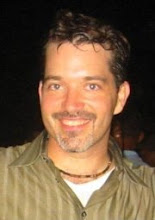My students are currently reading Alma's book, Dancing with Cuba, as well as Ned's, Cuba and its Music. In a previous post I introduced Ned and his Postmamboist method of using music to understand history (and vice versa). You can read my own review of these two essential books (along with a few others on Cuban music) here.
Kicking off the conversation, Ned made the mistake of starting with one of his favorite lines (and he meant it as a compliment):
"Dancing is really a form
of intense listening (to music)."
Not missing a beat, Alma shot back with a smirk:
"Well, I agree with the spirit of what you say,
but playing music is really a subsidiary form
of dance, don't you think?"
Yes, those are Mardi Gras beads around Alma's neck in honor of Carnival!
Then, in this same spirit of witty and deeply felt exchange of ideas, Alma and Ned swaped stories of teaching modern dance in Havana in 1970 in a highly chaotic and politically charged atmosphere (Alma) and falling in love with Cuba while recording Timba and Rumba greats like "NG" La Banda, Los Van Van, and Los Muñequitos de Matanzas starting in 1990 (Ned).
It was truly fascinating to hear them share their intense memories of their stays in Cuba during these two very different but equally heady times. Remember, 1970 was the grand climax and even grander failure of the 10-million-ton sugar harvest that wasn't. And of course, during the early 1990s Cuba was enduring the very worst of the "special period" economic crisis following the collapse of the Soviet Union.
Escuela de Danza Moderna, Havana. Architect: Ricardo Porro.
Photo: Paolo Gasparini. Courtesy of John A. Loomis.
From Bomb Magazine.
It was also quite a joy to hear the sparks fly as two accomplished writers on Latin America and the Caribbean began to riff back and forth on one anothers' ideas, memories, turns-of-phrase, and powerful emotions.
 Alma was originally trained to be a modern dancer in late 1960s New York under the tutelage of Merce Cunningham, Martha Graham, and Twyla Tharp, and only became a writer, she explained, after she took five full years to "recover" from dancing with the encouragement of an uncle who owned a press service.
Alma was originally trained to be a modern dancer in late 1960s New York under the tutelage of Merce Cunningham, Martha Graham, and Twyla Tharp, and only became a writer, she explained, after she took five full years to "recover" from dancing with the encouragement of an uncle who owned a press service.She has written four books that I know of, publishes articles frequently in The New York Review of Books and The New Yorker, and is currently part of a team producing the new opera, Revolution of Forms, based partially on her own memoir and John Loomis' wonderful eponymous archetectural study of the rise and fall of Cuba's National Schools of Art. For a great set of photos of the amazing, half-ruined art schools see my color shots above and below or go here for others I did not take. Gary Marx also wrote a nice piece in the Chicago Tribune on rediscovering them back in 2004.
Ned first trained to be a classical Spanish guitarist with Héctor García in New Mexico and Emilio Pujol in Spain before turning to Country and Western bar room music briefly, and finally to his life's love, Salsa, in 1980's New York. Exactly 20 years ago last month he made his first trip to Cuba (one of like 25 I think). It seemed to make as deep and lasting an impression on him as Alma's visit had on her 20 years earlier.
Their combined musical, journalistic, and artistic production since then has surely been extraordinary!










Nice paper! Thanks for sharing. You've given me some reading material I can't believe I've missed. Is Sublette working on a post 1952 book still?
ReplyDeleteSome recent Cuban comps I recommend:
Si Para Usted - Vols 1 & 2
Gilles Peterson Presents Havana Cultura
Nueva Vision: Latin Jazz and Soul from Egrem/Areito
Afro Cuban Kaleidascope
Revolucion: Original Cuban Grooves 1967-1978
Wow, two of my favorite writers! What a dream for your students. I have read Alma's "Samba" and in fact recorded it as a book on tape for a dancer friend who is visually impaired. Thanks for sharing these reports from your class with us distance learners on the web.
ReplyDelete